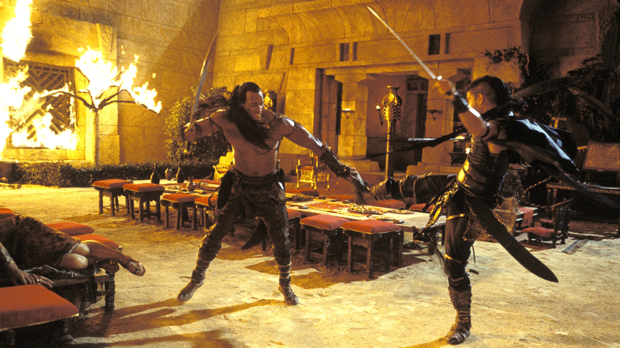 Memoirs of an Invisible Man (1992) Warner Bros./Comedy-Sci-Fi RT: 99 minutes Rated PG-13 (language, some mild violence, suggestive material) Director: John Carpenter Screenplay: Robert Collector, Dana Olsen and William Goldman Music: Shirley Walker Cinematography: William A. Fraker Release date: February 28, 1992 (US) Cast: Chevy Chase, Daryl Hannah, Sam Neill, Michael McKean, Stephen Tobolowsky, Jim Norton, Pat Skipper, Paul Perri, Richard Epcar, Steven Barr, Gregory Paul Martin, Patricia Heaton, Barry Kivel, Donald Li, Rosalind Chao. Box Office: $14.3M (US)
Memoirs of an Invisible Man (1992) Warner Bros./Comedy-Sci-Fi RT: 99 minutes Rated PG-13 (language, some mild violence, suggestive material) Director: John Carpenter Screenplay: Robert Collector, Dana Olsen and William Goldman Music: Shirley Walker Cinematography: William A. Fraker Release date: February 28, 1992 (US) Cast: Chevy Chase, Daryl Hannah, Sam Neill, Michael McKean, Stephen Tobolowsky, Jim Norton, Pat Skipper, Paul Perri, Richard Epcar, Steven Barr, Gregory Paul Martin, Patricia Heaton, Barry Kivel, Donald Li, Rosalind Chao. Box Office: $14.3M (US)
Rating: ** ½
It’s a weird one this Memoirs of an Invisible Man. It’s billed as a Chevy Chase comedy, but it’s directed by John Carpenter. It’s a movie in search of an identity. It can’t decide if it wants to be a rom-com or serious thriller. It leans towards the latter, the less interesting of the two, but still can’t maintain a consistent tone thus confounding the viewer.
Chase stars as Nick Holloway, a stock analyst who likes to play it “fast and loose”. This applies to both his career and life. He typically avoids making personal connections until he meets Alice (Hannah, Splash), a smart and attractive documentary filmmaker with whom he shares an instant attraction. It looks like something could come of this until Nick develops an invisibility problem. He shows up very hung over for a shareholders’ meeting at a scientific facility and becomes so bored with the long droning presentation that he sneaks out to take a nap. While he sleeps, a lab accident renders portions of the building and Nick invisible.
Since the lab is partially funded by the government, the CIA is called in to contain the situation. The agent in charge David Jenkins (Neill, Dead Calm) spots Nick and decides to “recruit” him as his condition makes him the perfect spy. Adverse to any form of responsibility, Nick escapes with the intention of finding a way to reverse his condition. This entails finding the guy in charge of the experiment, Dr. Wachs (Norton, Straw Dogs), and demanding he set things right (“I want my molecules back!”).
All the while, Jenkins and his men try to locate and capture Nick before the public finds out what happened to him and the lab. Herein lies a gap in logic. If it’s supposed to be a secret assignment, where is the sense in agents firing tranquilizer guns at invisible targets in public parks or running the streets wearing infrared goggles? The last time I checked, clandestine operations didn’t involve any of this. It’s bound to attract some attention, don’t you think?
After taking some time to acclimate to his new physical state, Nick reaches out to Alice who takes the news better than most people would. It doesn’t matter to her that she can see right through him. This is one of the areas where Memoirs of an Invisible Man succeeds. All new romances come with complications- e.g. jealous exes, hostile friends, demanding careers, freak lab accidents, etc. Like all couples, they have some logistical problems to work out. How do they make it work when he can see her, but she can’t see him? How are they supposed to go out in public? What about sex? How does that work? This is what Memoirs of an Invisible Man should have been about, the comic absurdity of their situation not some tired thriller with a psycho CIA spook making life hell for the protagonist.
While I don’t think Chase is right for the lead, I do like what Carpenter does with his character. When movie characters become invisible, it usually goes in one of two directions. Either they go completely psycho (the original 1933 The Invisible Man with Claude Rains) or sneak into girls’ locker rooms (1983’s The Man Who Wasn’t There with Steve Guttenberg). Memoirs of an Invisible Man gets philosophical about the perils of being invisible and not being able to enjoy life. Nick learns the hard way he can only consume clear liquids and foods. He can’t contact anybody for fear they’ll turn him over to the feds. The irony is that Nick lived an invisible life before the accident- i.e. no family, hardly any friends, job indifference, etc. This is an idea worth exploring further but the movie isn’t serious-minded enough for that. All we get is a lot of weak comedy and a recycled thriller plot.
In brief, Chase seems to think he’s playing Fletch again, but he has decent chemistry with Hannah who’s pretty good here. Neill’s hammy performance is out of step with the rest of the movie. The cast also includes Michael McKean (This Is Spinal Tap) as Nick’s phony friend and Stephen Tobolowsky (Groundhog Day) as Jenkins’ increasingly concerned CIA boss.
The special effects, the work of ILM, are very good in that they address long-standing questions about invisible men. For example, what happens when they eat? Logically, you should be able to see the food inside their stomachs. It finally happens in Memoirs of an Invisible Man in a scene that follows up with the answer to another big question. What does it look like when an invisible man vomits? It’s as gross as you think it is although not John Waters-level gross. In any event, the visuals are rather impressive on a small scale. I like the scene that shows Nick’s lungs filling up with smoke after he inhales on a cigarette.
It’s a shame the screenplay isn’t as clever as the movie’s visual aspects. It has some good ideas, but casts them aside in favor of trying to keep Memoirs of an Invisible Man conventional. It hurts the movie in the long run. It has some fun bits, but the parts don’t really gel into a consistent whole.




